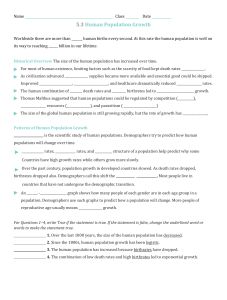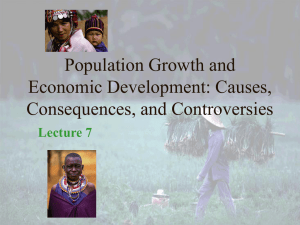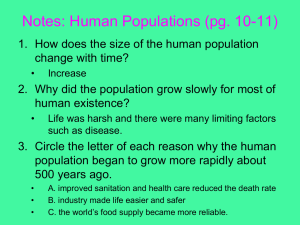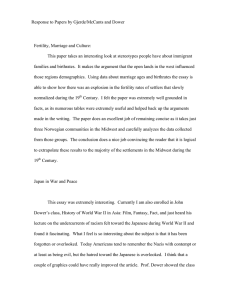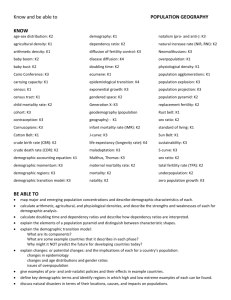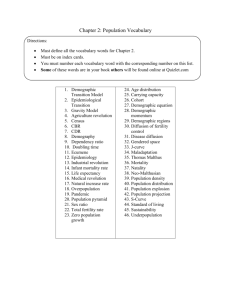Population Growth & Economic Development Presentation
advertisement
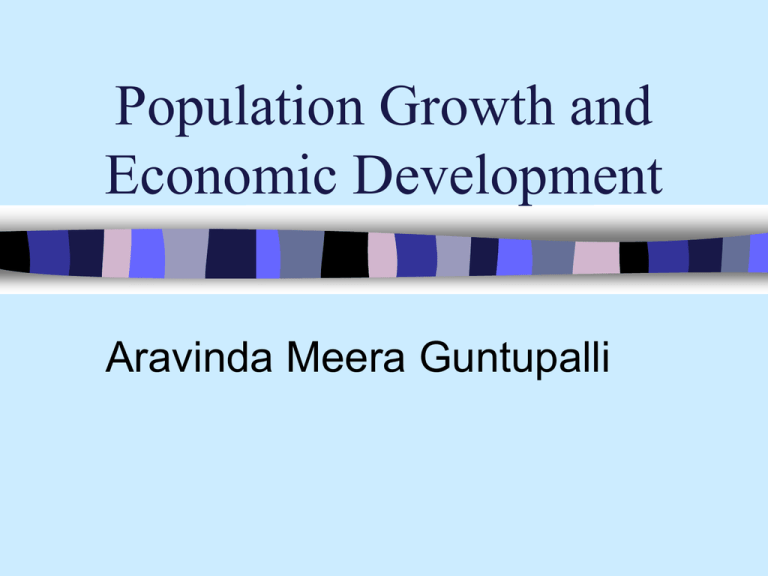
Population Growth and Economic Development Aravinda Meera Guntupalli Facts on world population Total world population: 6.1 billion About 75% of people live in developing countries About 60% of the population lives in Asia and Oceania About 40% of people live in only 15 countries By 2200, over 90% of population will live in what today are developing countries Topics Demographic measures Population growth in the world Theories of population Policies Demographic measures Birthrate Death rate Rate of natural increase Infant mortality rate Life expectancy at birth Doubling time Dependency ratio Terms used Fertility Mortality Migration Age structure Hidden momentum of population growth Population and economic growth Reduction in birthrates can raise percapita income in 2 ways lower dependency ratio low consumption and high savings Shift of labor force investment from capital widening to capital deepening Different issues related to development Some important quality of life indicators related to population growth – Improvement of levels of living – Increase in the labor forces – Higher population growth rates and poverty – Quality of health care and education – Relationship between poverty and family size Population Growth, 1750-2200: World, Less Developed Regions, and More Developed Regions Population Pyramids: Less Developed and More Developed Countries; 1998 The Demographic Transition Stage I: high birthrates and death rates Stage II: continued high birthrates, declining death rates Stage III: falling birthrates and death rates, eventually stabilizing Dependency problems Old age structures and young age structures both create problems with supporting dependents; they are just different problems. Young age structure requires expanding labor markets, investments in education Investments in older people less likely to enhance productivity The present demographic transition in developing countries Stage II already occurred in most of the developing world,but with higher birthrates than in the developed world. Stage III: – has been similar to developed countries for some developing countries like Taiwan, South Korea, China,Chile, Costa Rica – has not occurred yet for other countries mainly in Sub-Saharan Africa and the middle east. Rapid and Slow Transition Rapid transition Japan South Korea Taiwan Singapore Thailand Indonesia Slow Transition Pakistan India Bangladesh Philippines Papua New Guinea Miracles of rapid transition in East Asia Rapid demographic change creates windows of opportunity for accelerated economic growth – – – – Rapid growth of labor force Saving and investment Changing roles of women Human resource investment Stage of Demographic Transition and population requirement Population growth may be good at the beginning In the middle factors like political stability, cultural resources, and economic efficiency may be much more important than population growth Reaching high income may require slowing growth Fertility and income Malthusian population model 1798 Population tends to grow at a geometric rate, doubling every 30 to 40 years Food supplies only expand at an arithmetic rate due to diminishing returns to land (fixed factor) Malthusian population trap: countries would be trapped in low per-capita incomes (per capita food), and population would stabilize at a subsistence level. – Preventive and positive checks – Technological progress is not considered Household theory of fertility Family size is a decision taken at the microeconomic level by households based on a rational economic decision on “demand for children” Income effect: Higher income allows for larger family size Substitution effect: Higher cost of children implies smaller family size Other theories Why are there so many children in poor countries? Because children are an “investment” rather than a “consumption good” the “expected return of theinvestment” is given by child labor and financial support for parents in old age Parents have children up to the point at which their marginal economic benefit is equal to marginal cost Hidden momentum of population growth It is the tendency of population growth to continue, even after birthrates have decline substantially. – Substantial changes in birthrates may take decades – when the young population is large, in the near future high-fertility population will be high,even if fertility levels are lower. Policy approach to deal with the high population growth Decrease “marginal economic benefit of children”: Increase the minimum-age child labor provide better old-age social security Increase “marginal cost of children” Increase education, employment and wages for women Policy approach Better water and public health programs in rural and urban poor areas to lower infant mortality Implementation of family-planning programs Improvement of quality of care of health and family planning programs Monetary subsidies to small families Political commitment and role of religious leaders
